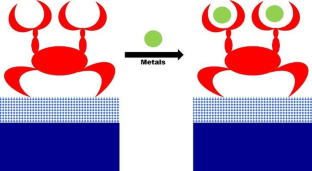Journal of Fluorescence ( IF 2.7 ) Pub Date : 2024-04-16 , DOI: 10.1007/s10895-024-03697-7 Muhammad Saleem , Abrar Hussain , Salah Uddin Khan , Sajjad Haider , Ki Hwan Lee , Sang Hyun Park

|
This study was based on the development of surface-based photoluminescence sensor for metal detection, quantification, and sample purification employing the solid sensory chip having the capability of metal entrapment. The Co(II), Cu(II) and Hg(II) sensitive fluorescence sensor (TP) was first synthesized and characterized its sensing abilities towards tested metal ions by using fluorescence spectral investigation while the synthesis and complexation of the receptor was confirmed by the chromogenic, optical, spectroscopic and spectrometric analysis. Under optical investigation, the ligand solution exhibited substantial chromogenic changes as well as spectral variations upon reacting with copper, cobalt, and mercuric ions, while these behaviors were not seen for the rest of tested metallic ions i.e., Na+, Ag+, Ni2+, Mn2+, Pd2+, Pb2+, Cd2+, Zn2+, Sn2+, Fe2+, Fe3+, Cr3+, and Al3+. These colorimetric alterations and spectral shifting could potentially be employed to detect and quantify these specific metal ions. After the establishment of the ligand’s selective complexation ability towards selected metals, it was fabricated over the substituted porous silicon surface (FPS) keeping in view of the development of surface-based photoluminescence sensor (TP-FPS) for the selected metal sensation and entrapment to purify the sample just be putting off the metal entrapped sensory solid chip. Surface characterization and ligand fabrication was inspected by plan and cross sectional electron microscopic investigations, vibrational and electronic spectral analysis. The sensitivity of the ligand (TP) in the solution phase metal discrimination was determined by employing the fluorescence titration analysis of the ligand solution after progressive induction of Co2+, Cu2+, and Hg2+, which afford the detection limit values of 2.14 × 10− 8, 3.47 × 10− 8 and 3.13 × 10− 3, respectively. Concurrently, photoluminescence titration of the surface fabricated sensor (TP-FPS) revealed detection limit values of 3.14 × 10− 9, 7.43 × 10− 9, and 8.21 × 10− 4, respectively, for the selected metal ions.
中文翻译:

Symmetrical Ligand 制造的基于多孔硅表面的光致发光传感器用于金属检测和捕获
本研究基于表面光致发光传感器的开发,用于金属检测、定量和样品纯化,采用具有金属捕获能力的固体传感芯片。首先合成了Co(II)、Cu(II) 和 Hg(II) 敏感荧光传感器(TP),并通过荧光光谱研究表征了其对测试金属离子的传感能力,同时通过荧光光谱研究证实了受体的合成和络合。显色、光学、光谱和光谱分析。在光学研究中,配体溶液在与铜、钴和汞离子反应时表现出显着的显色变化以及光谱变化,而其余测试金属离子(即 Na +、Ag +、Ni 2 )则没有观察到这些行为+、Mn 2+、Pd 2+、Pb 2+ 、 Cd 2+ 、 Zn 2+、Sn 2+、Fe 2+、Fe 3+、Cr 3+和Al 3+。这些比色变化和光谱偏移可用于检测和量化这些特定金属离子。在建立配体对选定金属的选择性络合能力后,在取代的多孔硅表面(FPS)上制造它,同时考虑到基于表面的光致发光传感器(TP-FPS)的发展,用于选定的金属感觉和捕获纯化样品只是为了除去金属包埋的感官固体芯片。通过平面和横截面电子显微镜研究、振动和电子光谱分析来检查表面表征和配体制造。配体(TP)在溶液相金属辨别中的灵敏度是通过在Co 2+、Cu 2+和Hg 2+的逐步诱导后对配体溶液进行荧光滴定分析来确定的,其提供的检测极限值为分别为2.14×10-8、3.47 × 10-8和3.13× 10-3。同时,表面制造传感器(TP-FPS)的光致发光滴定显示所选金属离子的检测极限值分别为 3.14 × 10 - 9、7.43 × 10 - 9和 8.21 × 10 - 4 。



























 京公网安备 11010802027423号
京公网安备 11010802027423号